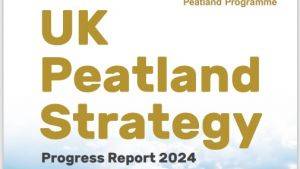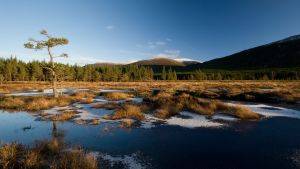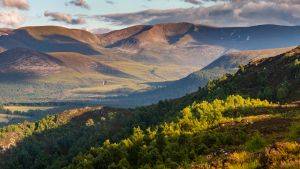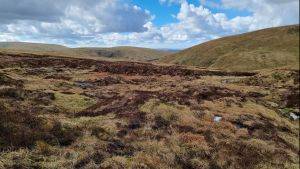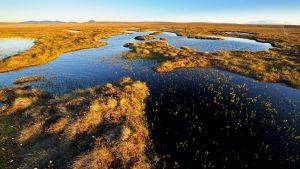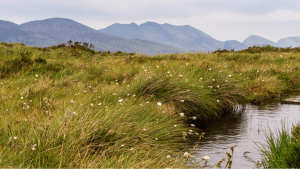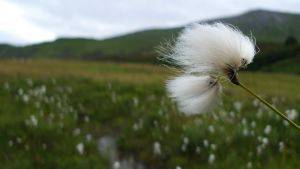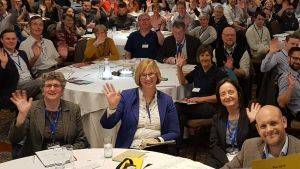Bois-del-Bel Research
Introduction
The Peatland Ecology Research Group (PERG), in concert with the Canadian peat industry and governmental agencies, has undertaken research to restore harvested peatlands into functional peat accumulating systems. Yet, it seems arduous to evaluate restoration success for specific ecological functions in small plots, which were the focus of former research projects. Several processes, particularly hydrological ones, can only occur and be studied at the scale of the entire ecosystem. This might also be true for the return of peatland animal populations, for which individuals often occupy large territories.
The restoration project takes place on the mined sector of 11.5 ha where peat harvesting occurred at the Bois-des-Bel peatland (BDB), which is located close to Rivière-du-Loup (Québec, Canada). Peat harvesting activities were stopped in 1980 and since then, the harvested sector was left abandoned. The site offered many advantages:
- A slow natural colonization by plants, emphasizing the need of undertaking restoration efforts;
- no peat extraction activities near the zone to be restored;
- the presence of a notable natural sector allowing the comparison with original conditions, and
- free access to the site for a period of at least 15 years.
Description
The Bois-des-Bel peatland is located in the Bas-Saint-Laurent region (47° 58' N, 69° 26' W), on the south shore of the St. Lawrence River, eastern Québec, Canada. It is located in the agricultural plain, bordered to the northwest by the St. Lawrence River and to the southeast by the Appalachian foothills, near Rivière-du-Loup. This plain is a narrow (16 km), low-altitude (0-250 m) strip of sand, silt and clay surficial marine deposits. The Bois-des-Bel bog covers an area of 202 ha, at a mean elevation of 15 m. Maximum peat thickness is 3.75 m. The vegetation of the bog is characterised by a mosaic of open or forest patches dominated by black spruce, ericaceous shrubs (mainly Kalmia angustifolia, Ledum groenlandicum and Vaccinium angustifolium) and mosses (mainly Pleurozium schreberi, Sphagnum angustifolium and S. russowii). The Bois-des-Bel peatland is one of the last bogs in the Bas-Saint-Laurent region that have not been extensively mined for the production of horticultural peat. However, in 1972, a small sector (11 ha) was drained and cleared to extract peat using tractor-drawn vacuum machines. Mining of the site ended in 1980.
Project Aims
The general goal of ecological restoration of peatlands is to restore the most unique characteristic that defines that peatland ecosystem: that is its capacity to accumulate peat through time.
Long-term goals associated with this project were:
- Return of full biodiversity;
- resistance to invasive species;
- return of the diplothelmic hydrological layers to restore the specific hydrological regime of peatlands;
- restore the trophic organization of plants and animals into food webs resembling the ones found in the ecosystem references;
- return of productivity, decomposition and nutrient retention so that peat can start to accumulate;
- resistance to disturbance regimes such as inundation, frost heaving, fire according to natural variability as determined by paleoecological tool.
Specific short terms goals were also defined:
- To stabilise the extensive bare peat landscapes to stop erosion problems;
- to improve visual amenity and recreation;
- to rewet to impede further CO2 emissions;
- to favor reestablishing predominately Sphagnum plants.
Restoration Delivered
Intensive monitoring of the site shows that, 10 years after restoration (2010), peat moss establishment increased steadily, reaching a cover that is now only slightly less abundant than in the pristine surrounding peatland. Insect species typical of natural peatlands do recolonize the restored sectors, but their abundance remains lower than in natural peatlands. For amphibians however, tadpoles, juveniles and adults occur more often in man-made pools than in pools of natural peatlands, as a result of a higher pH in the restored area than in natural peatlands. The water table in the restored portion of the site is higher than prior to extraction, but also fluctuates more than in a natural peatland. Ongoing research is currently studying the carbon exchanges at the site to evaluate whether the restored peatland acts as a carbon sink or not. An intensive survey of the site is planned for 2017, where vegetation, hydrology and carbon fluxes will be monitored.
Site Activity
After a year of calibration and site description (1999), the restoration work started in the autumn of 1999, and was completed in the autumn in 2000. The restoration work was planned and executed with the active collaboration of peat industries. In brief, peatland vegetation (including plants fragments, roots and rhizomes) was collected from a natural peatland and spread on the freshly flattened peat surface. The plant fragments were covered with straw (for protection against desiccation) and fertilized with a low dose of phosphorous. The site was rewetted by blocking the drainage ditches. This restoration technique is called the Moss Layer Transfer Technique. This restoration technique was applied on most of the site (8.4 ha), i.e. on 8 out of the 11 peat fields. The two first peat fields were left unrestored on the eastern side, to serve as a comparison site (2.1 ha). Between these two zones, one peat field is used as a buffer zone (1 ha). Since 1999, extensive monitoring is performed by the PERG to evaluate the success of the restoration. A large database is being built for the long-term monitoring regarding the evolution of the vegetation cover, hydrology, carbon fluxes, microbiology and chemistry, as well as the return of fauna.
Project Name: Bois-del-Bel Research
Organisation / Lead partner: Canadian Sphagnum Peat Moss
Location: Bois-des-Bel, Quebec, Canada
Approximate area covered: 11.5 ha
Predominately: Upland
Project Type: Restoration, Research
Year Project Began: 1999

